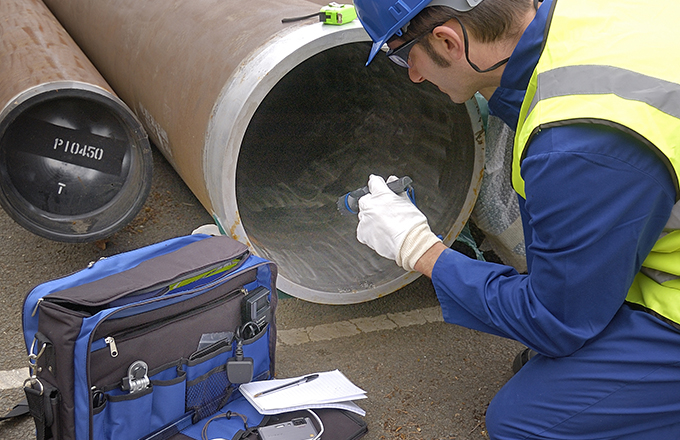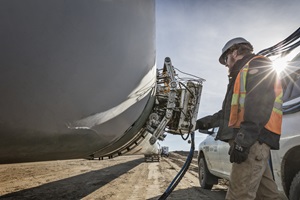Comprehensive Guide to Pipe Welding Inspection: Guaranteeing Stability and Safety in Pipe Construction and Upkeep
The honesty and safety and security of pipelines are vital in today's infrastructure landscape, emphasizing the critical role of welding inspection in pipe building and construction and upkeep. A detailed guide on this subject not just highlights the need of evaluating weld quality however likewise resolves the different evaluation strategies readily available, such as ultrasonic and radiographic testing. By recognizing typical defects and their effects, stakeholders can apply finest practices that make certain compliance and durability. Nevertheless, the intricacies associated with welding inspection raise relevant questions about industry requirements and the progressing innovations that might redefine these methods.

Importance of Welding Inspection
Welding evaluation plays an essential duty in making sure the stability and safety of pipeline systems. It functions as an essential process that confirms the quality and dependability of welded joints, which are commonly one of the most weak spots in pipe construction. Via organized evaluation, examiners can determine potential issues such as cracks, porosity, and incomplete combination, which may compromise the architectural stability of the pipeline.
The value of welding evaluation prolongs past plain conformity with market standards; it also safeguards public health and the setting. If failures occur, pipes carrying hazardous materials present considerable threats. Effective evaluation methods assist protect against leakages and tears, minimizing ecological damage and shielding neighborhoods. In addition, extensive examinations can enhance the long life of pipe systems, minimizing the demand for pricey repairs and downtime.
Along with making certain security and conformity, welding examination promotes a culture of quality control within companies. By focusing on inspection throughout the welding process, business can develop an online reputation for dependability and quality, inevitably bring about raised client confidence and service opportunities (Pipeline Welding Inspection). Therefore, the significance of welding assessment can not be overemphasized in the context of pipeline building and construction and upkeep
Secret Welding Procedures
Different welding procedures are used in pipe construction, each with its very own benefits and applications. Among the most widely utilized approaches are Protected Metal Arc Welding (SMAW), Gas Tungsten Arc Welding (GTAW), and Gas Steel Arc Welding (GMAW) SMAW is preferred for its adaptability and capacity to carry out well in numerous ecological conditions, making it suitable for area applications.
GTAW, typically referred to as Tungsten Inert Gas (TIG) welding, is recognized for its ability to produce top notch welds with excellent control over warm input, making it ideal for thin-walled pipes and stainless steel materials. GMAW, or Metal Inert Gas (MIG) welding, provides high deposition rates and is reliable for large-scale projects, usually used in the fabrication of pipelines in regulated environments.
Furthermore, Immersed Arc Welding (SAW) is made use of for its deep penetration and high performance, particularly in the building of large-diameter pipes. Each of these procedures adds to the total honesty and security of pipe constructions, making it possible for welders to pick one of the most ideal technique based upon material kind, job demands, and environmental conditions. Comprehending these crucial welding processes is important for effective pipe welding inspection.
Usual Issues and Their Effect

Porosity, identified by little gas pockets entraped within the weld, deteriorates the product and can result in leaks. Splits, which might take place due to thermal stress and anxieties or incorrect cooling, can result and propagate in structural failure under stress. Damaging, where the base steel is worn down along the weld bead, lowers the effective cross-section of the pipe, enhancing the risk of crack.
Insufficient fusion takes place when the weld steel does not effectively bond with the base metal, resulting in weak areas that may stop working under stress. Slag incorporation, the entrapment of non-metallic product within the weld, can likewise compromise the joint's integrity. Recognizing and resolving these flaws early in the construction procedure is essential to making sure the lasting dependability and safety and security of pipe systems, consequently protecting both the infrastructure and the setting.
Inspection Methods and Tools

Visual evaluation is the initial line of defense, permitting assessors to recognize surface area irregularities, imbalance, or various other visible issues. Ultrasonic screening employs high-frequency audio waves to discover inner defects, supplying accurate depth measurements and characterizing problems without harming the weld. Radiographic testing utilizes X-rays or gamma rays to produce photos of the weld, making it possible for the identification of internal gaps, splits, or incorporations.
Magnetic bit screening is particularly effective for finding surface Extra resources and near-surface discontinuities in ferromagnetic materials. This strategy entails applying a magnetic area and great iron particles to the weld, revealing flaws via the build-up of particles at problem sites.
In enhancement to these techniques, specialized devices such as automated ultrasonic testing tools and electronic radiography systems enhance inspection accuracy and performance, making sure a thorough analysis of pipe welds throughout building and construction and upkeep.
Best Practices for Compliance
Complying with finest techniques for conformity in pipe welding inspection is crucial for making sure the stability and safety and security of the facilities. Organizations needs to establish an extensive high quality monitoring system that aligns with market standards such as ASME, API, and AWS. This includes establishing comprehensive welding procedures that define the credentials, methods, and materials needed for welders.
Regular training and qualification of assessment workers are necessary to keep high proficiency degrees. Assessors should recognize with different non-destructive screening (NDT) approaches, consisting of ultrasonic screening, radiographic screening, and visual inspection, to effectively determine possible defects.
Paperwork plays an important function in compliance; maintaining accurate documents of examinations, weld procedures, and employees credentials aids to make sure traceability and responsibility. Arranged audits and testimonials of welding practices ought to be conducted to identify locations for enhancement and ensure adherence to established methods.

Conclusion
To conclude, the execution of strenuous welding examination procedures is extremely important for ensuring the integrity and security of pipeline building and construction and maintenance. By recognizing defects and employing advanced inspection techniques, organizations can substantially boost the high quality of bonded joints. Complying with ideal practices promotes conformity with industry criteria, inevitably guarding public health and wellness and avoiding ecological hazards. Continuous enhancement in examination procedures will add to the long life and reliability of pipe systems, underscoring the critical role of welding assessment in the industry.
The honesty and safety of pipes are paramount in today's infrastructure landscape, underscoring the essential function of welding examination in pipe building and construction and maintenance. Comprehending these key welding procedures is necessary for effective pipe welding examination.
Sticking to finest practices for compliance in pipeline welding inspection is critical for making sure the honesty and security of the infrastructure.In conclusion, the application of extensive welding inspection methods is vital for ensuring the integrity and safety and security of pipe building and construction and upkeep. Continual enhancement in assessment procedures will add to the long life and reliability of pipe systems, highlighting the important function of welding assessment in the industry.